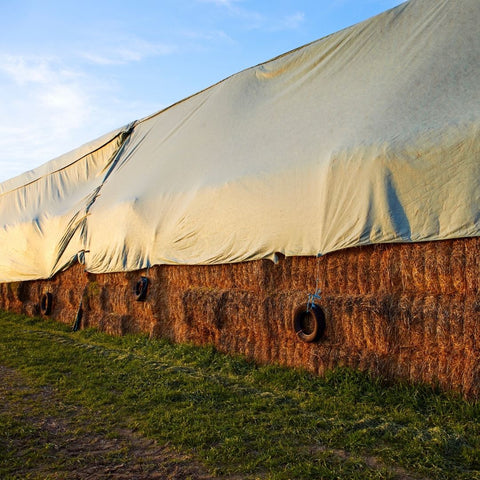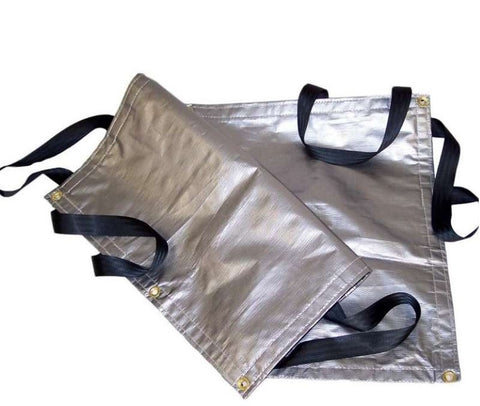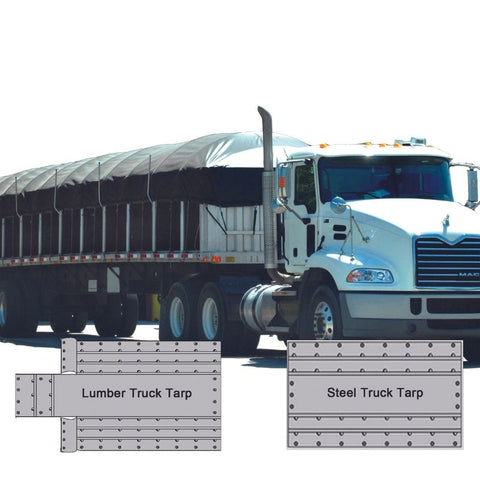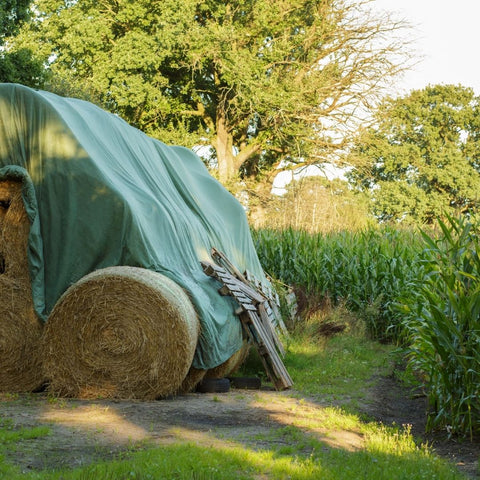Introduction: The Importance of Quality Hay Tarping
If you're involved in farming or hay storage, you know the critical importance of protecting your hay from the environment post-harvest. A fantastic way to achieve this is by using specialized Hay Tarps. These tools are not just effective in shielding your hay from natural elements, but they also play a pivotal role in prolonging the lifespan of your hay bales. This article will delve into the myriad advantages of Hay Tarps and how they can positively impact your crop yield.
Hay Tarps are indispensable for any agriculturalist looking to protect their precious crops. Made from robust, reinforced polyethylene, these covers boast a variety of features. Their resistance to UV rays, mildew, and rot, coupled with their 100% waterproof nature, guarantees that your hay remains dry, even in adverse weather conditions. They come in multiple sizes, ensuring a snug fit for your bales and are straightforward to install.
The primary advantage of Hay Tarps is the unparalleled protection they offer your crops. By safeguarding your hay against sun damage, heat, wind, rain, and snow, these covers act as a formidable barrier against harsh weather. Covering your hay with these essential tools not only extends the hay's life but also improves its quality. This means peace of mind, knowing that your hard work won't be undone by weather-induced spoilage or damage.
Moreover, Hay Tarps can significantly boost your crop yield. When your hay is well-protected, the likelihood of spoilage or damage reduces drastically. This results in harvesting a larger quantity of high-quality hay, enhancing your farm's profitability. Investing in Hay Tarps is akin to investing in your farm's future success.
The long-term financial benefits of using Super Heavy Duty Hay Tarps cannot be overlooked. By proactively protecting your hay, you minimize the need for frequent replacements. This leads to notable cost savings over time, enabling more efficient resource allocation. Think of it as a smart investment that pays dividends in both crop quality and financial health.
Selecting the Right Hay Tarp: Material and Durability Matters

Choosing the right tarp involves understanding the materials available and their durability. We'll delve into the types of tarps, focusing on those that offer UV protection, water resistance, and long-term durability.
Size and Fit: Ensuring Optimal Coverage
Getting the size right is essential. This section will guide you on measuring and selecting tarps that provide adequate coverage for your hay bales, taking into account different bale sizes and shapes.
Identify Bale Type: Hay bales come in various shapes and sizes. The most common types are round and square/rectangular bales. The size can vary significantly, with round bales typically ranging from 4 to 6 feet in diameter, and square bales varying in length, width, and height.
Measure Accurately: Use a measuring tape to determine the dimensions of your bales. For round bales, measure the diameter and length. For square bales, measure length, width, and height.
Installation Techniques: Secure Your Tarp for Maximum Protection

Learn how to properly install your hay tarp to withstand wind and weather. We'll cover anchoring methods, tensioning techniques, and tips for ensuring your tarp stays put.
Choosing the Right Location
Flat and Clear Area: Select a flat, clear area for laying out the tarp. Avoid places with sharp objects or debris that could tear the tarp.
Sunlight and Wind Consideration: Consider the direction of prevailing winds and sunlight exposure. Position the tarp in a manner that minimizes wind lift and maximizes sun protection.
Preparing the Tarp
Unfolding and Positioning: Carefully unfold the tarp over the hay. Ensure it covers the hay completely, with extra length on all sides.
Smooth Out Wrinkles: Smooth out any wrinkles or folds, as these can lead to water pooling or wind damage.
Anchoring Methods
Use Sturdy Anchors: Employ heavy-duty stakes or anchors at each corner of the tarp. For larger tarps, additional anchors along the sides may be necessary.
Secure Attachment Points: Make sure the tarp has strong attachment points like grommets or loops. If absent, consider reinforcing the edges.
Tensioning Techniques
Even Tension: Apply even tension across the tarp to prevent flapping. This can be achieved using ropes or straps.
Cross-Bracing: Utilize a cross-bracing technique by tying diagonal lines across the tarp’s surface for added stability.
Regular Inspection and Maintenance
Routine Checks: Regularly inspect the tarp for any signs of wear, tear, or loosening.
Immediate Repairs: Address any issues immediately to prevent further damage. Keep a repair kit handy for quick fixes.
Additional Tips
Overlap Tarps for Larger Areas: If covering a large area, overlap multiple tarps and secure them together.
Avoid Water Accumulation: Ensure the tarp is angled or positioned in a way that allows water to run off and not pool on the surface.
Consider Windbreaks: In windy areas, setting up windbreaks like temporary fencing can reduce the wind’s impact on the tarp.
Our Recommendation
Super Heavy Duty Hay Tarps

Super Heavy Duty Silver Black Poly Tarps

Super Heavy Duty Silver White Poly Tarps

Super Heavy Duty 16' X 25' Steel Truck Tarps

Lumber Truck Tarp

Maintenance and Care: Prolonging the Life of Your Hay Tarp

Proper maintenance can significantly extend the life of your hay tarp. By following a few simple guidelines, you can protect your investment and ensure your tarp remains functional for a longer period. We’ll provide advice on cleaning, storing, and inspecting your tarp for any wear and tear.
Regular Cleaning: Dirt, debris, and moisture can degrade the material of your hay tarp over time. To prevent this, clean your tarp regularly using mild soap and water. Avoid harsh chemicals, as they can weaken the fabric. After washing, ensure the tarp is completely dry before folding it up to prevent mold and mildew growth.
Proper Storage: When not in use, store your hay tarp in a cool, dry place. Avoid exposure to direct sunlight for prolonged periods as UV rays can cause the material to deteriorate. Fold the tarp neatly to prevent creases or damage to the fabric. Store it off the ground to protect it from pests and moisture.
Routine Inspections: Periodically inspect your tarp for signs of wear and tear. Look for small tears, holes, or areas where the material is thinning. Early detection of damage allows for timely repairs, which can prevent further deterioration. Use repair kits specifically designed for tarps to ensure a long-lasting fix.
Avoiding Sharp Objects: Be mindful of sharp edges and objects when using your hay tarp. These can easily puncture or tear the fabric. If you're covering hay on a rough surface, consider using a protective layer between the hay and the tarp.
Handling with Care: During installation and removal, handle your tarp gently. Dragging the tarp over rough surfaces or pulling it too tightly can cause unnecessary strain and damage. Enlist help if the tarp is large to avoid mishandling.
Mildew Prevention: In humid climates, tarps can be prone to mildew. To prevent this, ensure the tarp is completely dry before storage and consider using a mildew-resistant spray as an added layer of protection.
Professional Repairs for Major Damage: For significant damage, it might be best to seek professional repair services. They can provide the appropriate materials and expertise to extend the life of your tarp.
Conclusion: The Long-Term Benefits of Effective Hay Tarping

Hay Tarps are expertly designed for reliable hay protection. Their heavy-duty polyethylene material ensures complete waterproofing, UV resistance, and protection against mildew and rot. Additionally, these tarps prevent moisture accumulation, crucial for keeping hay in prime condition. The breathability of the materials allows for proper air circulation and moisture movement. If moisture is trapped, it can damage the hay beneath.
The flexibility and accessibility of Hay Tarps are major advantages. These covers offer the freedom to protect and store hay in your preferred location, unlike barns or fixed structures. This makes the process more adaptable, easier, and safer.
Crops exposed outdoors are inevitably affected by the elements. Premium Hay Tarps are made with highly UV-resistant materials, capable of enduring daily sun exposure without damage. Their durability ensures season after season of reliable protection.
Considering costs, hay storage in a barn or shed involves a significant financial commitment. In contrast, Hay Tarps represent a fraction of the cost, making them a more economical.
For those looking to improve the quality and longevity of their hay, Hay Tarps are an excellent choice. With their numerous benefits, these covers can greatly enhance your crop yield and safeguard your hard work. Give your hay the protection it deserves with Hay Tarps and experience the positive impact on your farm and crops. Your hay, and your bank account, will thank you for it. Prepare to enjoy the fruits of a prosperous and profitable harvest.
In conclusion, we'll revisit the importance of hay tarping and how it contributes to better feed quality, cost savings, and overall farm efficiency. We’ll also answer some common questions raised in the introduction.
By the end of this guide, you'll be equipped with the knowledge to choose and maintain the best hay tarp for your needs, ensuring your hay remains in top condition year-round.
FAQ’s
- What are Hay Tarps and Why are They Important for Protecting Hay?
Hay tarps are specialized coverings designed to protect baled hay from weather elements like rain, snow, and excessive sunlight. They are crucial for maintaining the quality of hay, as exposure to moisture can lead to mold growth and spoilage, while excessive sun can bleach and weaken the hay. Using hay tarps helps in preserving the nutritional value of the hay, making it a valuable investment for farmers and livestock owners.
- How Do I Choose the Right Size and Material for My Hay Tarp?
When selecting a hay tarp, consider the size of your hay stack and allow for extra coverage on all sides. The tarp should be large enough to cover the entire stack and have additional length and width for secure anchoring. The material of the tarp is also important; look for UV-resistant, waterproof, and breathable fabrics. Polyethylene tarps are a popular choice due to their durability and resistance to weather elements.
- What Are the Best Practices for Securing a Hay Tarp?
Securing a hay tarp properly is essential to ensure it stays in place and offers maximum protection. Use heavy-duty straps or ropes to tie the tarp down. Anchor points should be strong and evenly distributed around the stack. It's important to make sure the tarp is taut to prevent water pooling and wind damage. Regularly check the tarp for any signs of wear or tear and adjust the anchoring as needed.
- Can Hay Tarps Be Used for Other Purposes?
Yes, hay tarps are versatile and can be used for various other purposes. They are often used in agriculture for covering other types of feed or farm equipment. In addition, they can serve as temporary shelters, covers for vehicles, or as protective sheets during building projects. However, it’s important to note that using them for purposes other than hay protection might affect their longevity and effectiveness.
- How Do I Maintain and Store My Hay Tarp When Not in Use?
Proper maintenance and storage of hay tarps are key to prolonging their life. Clean the tarp regularly to remove dirt and debris. Inspect it for any rips or tears and repair them promptly. When not in use, dry the tarp completely to prevent mold and mildew growth. Fold it neatly and store it in a dry, cool place away from direct sunlight and sharp objects that could cause damage.





